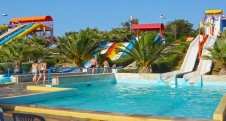
Crete Monasteries & cuisine Day visit. A trip to Vyzantine History and Religion of Crete.
|
From Hotel (Heraklion Estate) |
|
9:00 |
|
16:30 |
|
Friday |
|
50% |
|
Free |
|
01/06-30/09 |
|
Included |
Religious tradition is very notable in all areas of Crete and is present in everyday life of the Cretans. Crete has an autonomous Archbishop, separate from the rest of Greece. With thousands of places of worship and dozens of monasteries that have played a special role in the consolidation of Christianity and the struggle against the invaders, Crete is an ideal religious and historic destination.
Depature 9:00
1st Stop to Anopolis Monastery. We stay there for around 45'
2nd Stop to Agarathos Monastery.We stay there for around 45'
3rd Stop to Apanosifis Monastery.We stay there for around 45'
4th stop to ''MyrAgapi''
Return Time at around 16:30
Agarathos Monastery
The fortified monastery of Agarathos is located 23km east of Heraklion in a wooded location at an altitude of 538m near Episkopi. The monastery, especially during the Venetian Era, was one of the richest in Crete owning several other monasteries in Heraklion and Lassithi prefectures. It is considered the first in the hierarchy of the monasteries of the island.
The name is taken after the plant Jerusalem Sage (Phlomis fruticosa), named agarathia in Cretan dialect. According to the tradition, below such a plant a monk found once the icon of Panagia (Virgin Mary) and he later built the church of Panagia on the same site. In front of the church you will see a pomegranate tree with a candle near its trunk. The pomegranate is said to be the initial plant of agarathia, which was turned miraculously to a tree.
The male Agarathos monastery is one of the oldest in Crete and we do not know the exact date of its establishment. During the Venetian Era, it was a very rich monastery, with most of its monks coming from Cythera Island (near Peloponnese).
Many great personalities have connected their names with Agarathos. Among them is Meletius Pigas (later Patriarch of Alexandria), Cyril Loukaris (later Ecumenical Patriarch), Yerasimos Paleokapas (bishop of Crete) and the scholar Joseph Vryennios. In the Ottoman period, Agarathos played an important role in the revolutionary movements against the Turks.
The church of the monastery is double-aisled, with one aisle dedicated to the Assumption (celebr. 15 August) and the other to Saint Menas (celebr. 11 November). There is a very old icon of the Virgin Mary. Visitors of the monastery can be hosted in the guesthouse and the dining room of the monastery and admire the library with the old manuscripts. Outside the monastery, there is the old church of St. Raphael.
TIMELINE
1504: The sons of Matthew Kalergis, to whom the monastery belonged, grant Agarathos to the monk Nifon Notaras. Nifon turns the deserted monastery to a very rich coenobitic one, thus he is actually considered the founder of Agarathos.
1532: Agarathos is referred in a manuscript stored in the National Library of St Mark's in Venice.
1566: The ex-abbot of Agarathos, Silvestros, becomes Patriarch of Alexandria till 1590.
1583: The abbot Neophytos Patellaros curses the residents of the nearby village Founarous, as they caused major damage to the properties of the monastery. It is said that a boulder was then torn in two and flames came out. Since then the village is deserted.
1590: The former abbot Meletios Pigas becomes Patriarch of Alexandria till 1601, replacing Silvestros after his death.
1612: The former abbot of the monastery Cyril Loukaris becomes Patriarch of Constantinople till 1638, with some intermediate pauses.
1646: The abbot Athanasios Christoforos participates in the struggle of the Venetians and Cretans against the Turks. The Turkish Pasha Ahmet Kioproulis decides to destroy the monastery, but his friend bishop Neophytos Patelaris intervenes and changes Kioproulis’ mind. Athanasios leaves to Italy, taking several valuable objects with him.
1821: The monks of the monastery together with the Bishop of Hersonissos help at the preparations of the Revolution. The Turks occupy the monastery and set fire, slaughtering those monks who did not manage to escape.
1836: The monk Anthony Kalonas becomes bishop of Cythera and transfers the relics of the monastery (the ancient image of Orphan Panagia and numerous manuscripts) to Cythera.
1843: The Diocese of Hersonissos moves to the monastery of Agarathos.
1845: A mutual learning school starts operating for the children of the surrounding villages.
1856: By signing Chati Humayun, Christians are granted with more privileges. Repairing monasteries is no longer forbidden and Agarathos is extensively reconstructed.
1862: The bell tower of the church is built.
1883: The School of Christ is founded, later transferred to the Monastery of Christ in Sgourokefali village.
1893: A storm destroys the steeple of the church, which gets soon reconstructed.
1894: The new temple is built on the place of the older one and is inaugurated.
1896: The rebel Anthony Tryfitsos or Tryfopoulos uses Agarathos as a base against the Turks. The enraged Turks destroy the monastery, which gets later repaired.
1935: The monastery is declared as Preservable building.
1940: The church is rebuilt again.
1941-1944: During the German occupation, the monastery serves as a shelter for the locals.
1970: The abbot Cyril Chourdakis manages to get back the icon of the Virgin Mary and the old manuscripts from Cythera.
St John Monastery in Anopolis
The monastery of St. John Theologos (John the Apostle) in Anopolis is located relatively close to Heraklion. Although it has experienced the cruelty of the Turks during the Turkish occupation of Crete, the monastery still operates today. It is built in a beautiful valley at an altitude of 170m, southeast of Anopolis.
According to one version, the monastery initially belonged to the monastery of St. John in Patmos, hence the name. However, it is likely that it was a dependency of the seaside monastery of St Georges, near the exit of Aposelemis river, the temple of which was destroyed by the Germans in 1940. During the Venetian occupation, the monks of the monastery of St. George moved to Anopolis because of the constant pirate raids. They also transferred the icon of St. George, which still survives.
From the first sight, you’ll get impressed by the imposing church of St. John (celebr. on May 8), which was built next to the old church. The church is 33m long and has 33 doors (the years of Christ) and 107 doors and windows (the years of St. John).
TIMELINE
15-16th century: The Monastery of St. John belongs to the monastery of St Georges in Aposelemis. Its monks abandon St. George and move to Anopolis, because of the constant pirate raids.
1702: According to some locals, this is the true establishing date of the monastery.
1821: The Turks cause damages to the monastery.
1840: A primary school operates in the Monastery of Saint John for the Greek children from the region.
1866-69: The Turks destroy the monastery because of the revolutionary action of the monks. After the revolution, it gets completely restored.
1896: In July, the Turks slaughter all monks, in retaliation for their contribution to the revolution. The monastery gets deserted.
1904: Abbot Kallinikos Daskalakis re-founds the monastery.
1908: The school of the monastery terminates its operation and the responsibility of education is managed by the Cretan State. The monastery gets renovated.
2007: The new temple of St John is built next to the old one.
Monastery of St. George Apanosifis
the Monastery of St. George Apanosifis or Epanosifis is located about 30km south of Heraklion, near Metaxohori village. It is the largest male monastery in Crete (in monk number). The spiritual and social contribution of the monastery during the difficult years of Turkish occupation was invaluable.
The monastery was built at the end of the Venetian Era and it immediately gained fame. According to a written testimony, the monastery was founded by a monk of the monastery Apezana, who once started hiking to the monastery of Agarathos. During the course, he stayed overnight in the Church of St. George in the fief of the family Lagouvardos. He saw a dream with Saint George ,asking him to build the monastery at this position. However, Lagouvardos refused but he was convinced after being punished by the Saint. Lagouvardos paid for the construction of Epanosifis monastery.
The monastery of Epanosifis has many dependencies, such as the ruined monastery of Aistratigos northwest of the monastery, the monastery of St. Anthony, of Xera Xyla near Neapolis and several chapels.
In the monastery there are now precious heirlooms, gospels, carved crosses, a silver chalice of 1842, the icon of Saint George monastery of Xera Xyla and relics of 21 Saints. The monastery also houses a Higher Ecclesiastical School, in a building that was formerly an orphanage. Lastly, the church of St George celebrates on April 23 and November 3.
TIMELINE
1590-1600: A monk of the monastery Apezana, named Paisios, founds the monastery of Epanosifi in the fief of Langouvardos.
1697: A Turkish man is found murdered outside the monastery and his family suspects the monks of the monastery.
1718: Matthew Thalassinos, later Bishop of Arcadia (1763), becomes a monk at the monastery.
1758: The monastery acquires the monastery of Virgin Mary in Venerato and starts its restoration.
1821: The Turks kill 18 monks, while the rest ones leave to Sfakia. Manolis Tombazis takes many relics from the monasteries and transfers them to Hydra, where he sells them so as to buy weapons for the Cretan revolutions.
1821: The monk Neophytos from Aydin comes to the monastery and reconstructs the buildings.
1855: The abbot Gregory is elected as bishop of Arcadia and is established in the monastery till 1877.
1856: A strong earthquake levels the church of St. George and the left arm of St. George is lost.
1861-63: The church is restored.
1866: During the 1866 revolution, the monks join the rebels and the elderly ones leave the monastery, transfering the relics of the monastery to Apezana monastery. The Turks destroy and plunder Epanosifis.
1872: The monastery covers all the costs of Heraklion county schools.
1896: The monks take part in the Battle of Archanes.
1941-44: The monks take part in the Battle of Crete. The abbey is converted into a hospital and many families shelter in the monastery. The Germans, in retaliation, loot the monastery several times.
1968: A new complex of monk cells is built
1982: The statue of Eugene, the first archbishop of Crete, who was a monk of the monastery is built
“MyrAgapi” is the name given to the traditional complex created by the Korsava family with great care. It is located at the settlement of Stironas at the District of Panorama. The surrounding area is very beautiful and designed with great sensitivity. Inside you can find:
The traditional boiler where “stemfyla” (the must made from grapes, seeds, stems and grape-peels) boil in order to produce Raki of an excellent quality free from wood alcohol.
A Wine Cellar where house wine is stored and kept in oak barrels. This wine is handmade using grapes from its own selected production.
A Traditional fireplace which is the cozy corner of the complex.
Decoration with traditional rural objects, such as mowers, reaping hooks, plows, bells, reels, etc. But above all things that visitors will see and enjoy, they will have the chance to get traditional products not only raki and wine but also honey, herbs, olive oil, etc.

Take wonderful photos with your kids and enjoy a guiding tour in Amazonas Park, a private zoo, which allows your kids to test their skills in ceramics and enjoy interactive activities and attractions in Labyrinth Park, the most famous family destination.

Use Luxury Sedan Car for your 4 hours tour in Loutraki area and schedule your itinerary as you wish. Car Models: Mercedes Benz E-class or S-class, BMW Series 520-740 , Audi A4-A6 series.

For those looking to spend intense moments of fun on their vacation , it is suggested to visit the water parks in the area. In the region of Heraklion there are two water parks: Water City and Aqua Plus. It is designed for day trips with a large variety of choices in slides for aquatic adventures.
1039 Ε 6061 01515 00